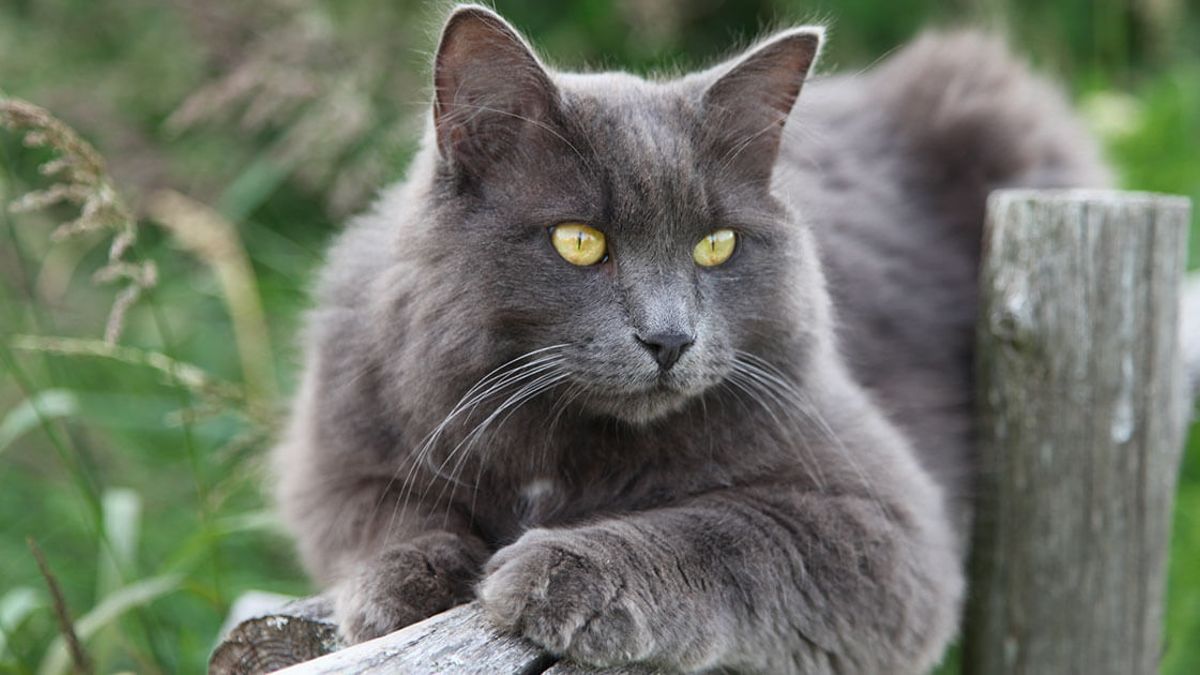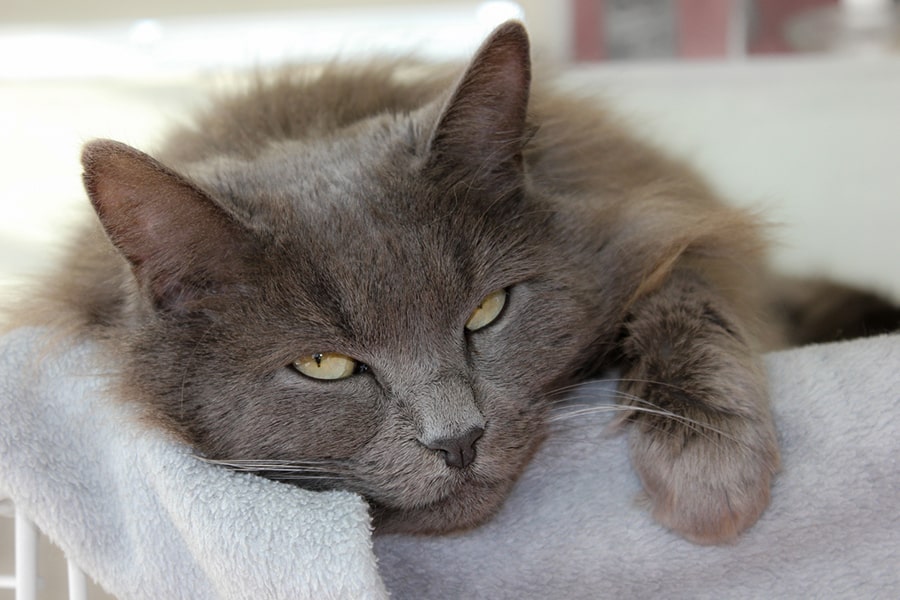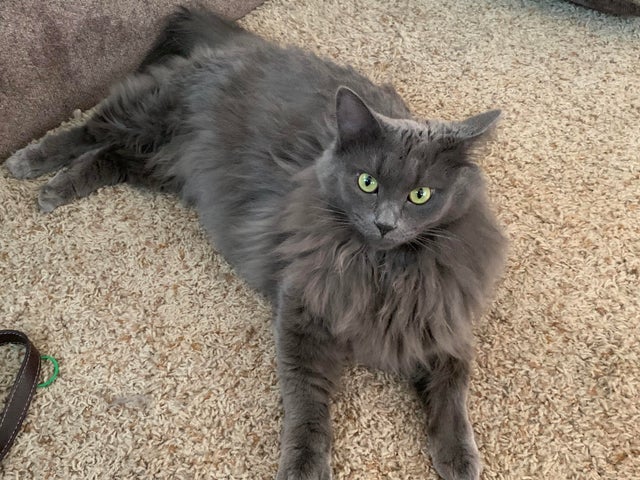With its silvery-blue fur and green shimmering eyes, the Nebelung is an extraordinary appearance. She likes many cat friends. But their breeding is still in its infancy.
Appearance

The elegant Nebelung impresses with its elegant, muscular build. They weigh between four and seven kilograms, with hangovers tending to be heavier. This makes them one of the medium-sized cats. The legs of medium strength are elongated and the paws are oval-shaped. The cat’s large, slightly pointed ears sit on the wedge-shaped head.
The Nebelung’s tail is hairy longer than the rest of the body. One of the most striking features of the Nebelung is its half-length, “blue” fur. From a purely genetic point of view, this is diluted black. The silver-colored hair tips, the “ticking”, create the impression that the cat’s fur has a silvery sheen.
The eye color varies from yellowish-green to pure green. According to the standard, the fogging must not have any fur markings such as spots or stripes. However, the fur can only be definitively assessed at the age of two. Younger Nebelung may have a slight “ghost drawing” pattern that fades over time.
History of the Breed

The origin of this breed of cats lies in the USA in the 1980s and was based on a coincidental mating of two neighbor cats: the black short-haired cat named Elsa, which had a long-haired father mated with a tom from the neighborhood who resembled a Russian Blue. Both in 1984 and a year later there was one kitten with blue, half-length fur among the kittens that were conceived. The owner Cora Cobb named these two after two heroic characters from the German Nibelungen saga: Siegfried and Brunhilde.
Cora Cobb discovered the uniqueness of the Nebelung and was now determined to found a new breed with her cats. She contacted TICA (The International Cat Association). The geneticist Dr. Solveig Pflueger helped her to write the breed standard. Cora Cobb was based on the breed standard of the Russian Blue. She only exchanged the passage about the permitted hair length: The Russian Blue has short hair, the Nebelung half-length hair.
Originally the breed was called “Nibelung” based on the heroic epic around Siegfried and Brunhilde. The breeder later decided to weaken the relationship to the historical substance. She changed the name to “Nebelung”, which is derived from the German word “Nebel” and the silvery sheen of the velvet paws. As early as 1987, the TICA recognized the newly created cat breed. The FiFe (Fédération Internationale Féline), however, has not yet recognized the Nebelung as an independent breed.
Temperament
A Nebelung may look mysterious and mystical. However, the elegant velvet paw prefers to be down-to-earth: She enjoys being caressed and playing with her two-legged friends. There doesn’t need to be too much action on the schedule – the Nebelung values calm and familiar routines. At the kitten age, like any four-legged friend, she is very playful and exuberant. In the beginning, this gentle cat is reserved for strangers. But if you have a little patience, you will get to know your charming being.
The Nebelung makes a good indoor cat. Variety is very important for the cat. You should therefore give the velvet paw a secure garden or balcony space and it is best to hold it together with a second fog. The daily get-together with your two-legged friend is also important for the sensitive cat. As a rule, it ties itself closely to one person and is therefore predestined for single households. If children live in the household, they should be advised on how to handle their four-legged friends correctly. In any case, the Nebelung should have a place of retreat.
Bless You

Little is known about possible health problems or diseases typical of the Nebelung breed. Some owners report that their four-legged friend is prone to diarrhea or vomiting. The Nebelung can quickly hit the stomach not only with unknown food but also with stress. That is why a balanced and cat-friendly diet is particularly important for this cat. The Nebelung is considered to be long-lived: a healthy animal can reach an age of 15 to 20 years.
Care Routine
As with all semi-long-haired cats, keepers of the Nebelung should use a comb or brush at least once a week to prevent matting. Daily brushing may be necessary during the change of coat in spring and autumn. It not only frees the cat from dead hair but also prevents it from spreading all over the home. If felt has already formed, you can untangle smaller areas with a detangling knife or a comb with rotating tines.
If you have made felt sheets, it is advisable to go to the vet. This can shear the cat with slight sedation if necessary. It is best to get used to the Nebelung in a playful way as a kitten to the regular brush wellness so that the adult velvet paws like to be combed. If nothing pulls, brushing strengthens the bond with people and is like a pleasant cat massage. Old cats in particular can also be dependent on regular nails being clipped.
Nebelung Diet

With a nutrition-sensitive cat like the Nebelung, it is particularly important to offer high-quality food. Therefore, make sure to choose a food with high meat content. If you want to change the feed, proceed slowly: Mix increasing proportions of the unknown feed into the familiar. This will minimize the risk of your Nebelung reacting with hypersensitivity reactions such as diarrhea or vomiting. Check the weight of your adult Nebelung every few months.
The half-length fur makes it harder to see if your cat is losing weight or has too many pounds on its ribs. But being overweight can also increase the risk of diseases such as diabetes or joint problems in four-legged friends. Radical diets are not an option. If you want to reduce your cat’s weight, opt for high-quality food in balanced portions and reduce the number of treats. Dry food should by no means always be freely available. In order to encourage the velvet paw to drink, it is best to set up several bowls in different places in the apartment. Make sure that the water and food bowl are not too close together.
Breed

Anyone looking for fog in Europe may have to accept long waiting and driving times. After all, over 30 years after its occurrence, the fog is still very rare. In addition to the USA, there are also breeders in Canada, Russia, and some European countries. In contrast to the TICA and some other large umbrella organizations, the FiFe has not yet recognized the Nebelung as an independent breed.
If you are looking for a Nebelung, you should only turn to reputable breeders. A responsible breeder is usually a member of a breed club. He takes care of the welfare of the mother and the kitten. He has his animals regularly examined by a veterinarian and attaches great importance to species-appropriate keeping and appropriate socialization of the young animals. Accordingly, the kittens should only be handed in with proof of parentage and a vaccination certificate. You should keep your distance from “multipliers” who offer “pedigree cats without papers”.
A trip to the local animal shelter is also always worthwhile. Although it is not very likely to find fog in the shelter, many fur noses are waiting there for a loving home. Perhaps a charming mongrel will wrap you around your paw here.
We hope you enjoy your elegant cat!



























